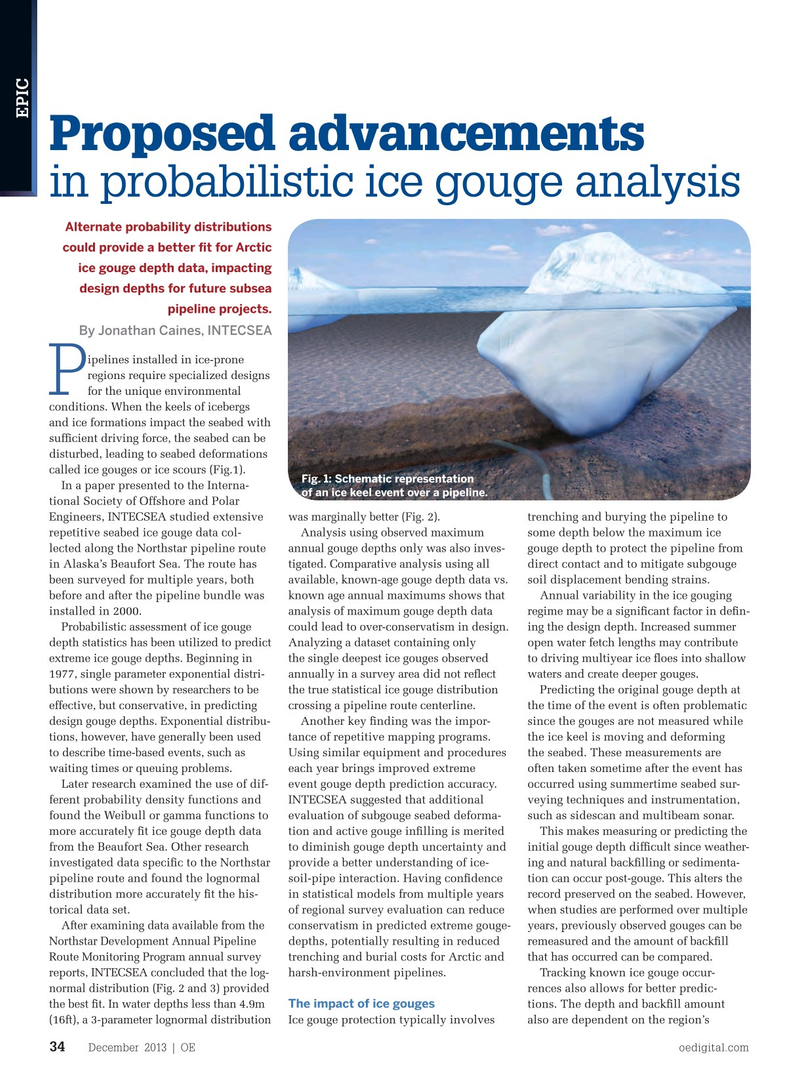
Page 32: of Offshore Engineer Magazine (Dec/Jan 2013)
Read this page in Pdf, Flash or Html5 edition of Dec/Jan 2013 Offshore Engineer Magazine
EPIC
Proposed advancements in probabilistic ice gouge analysis
Alternate probability distributions could provide a better ft for Arctic ice gouge depth data, impacting design depths for future subsea pipeline projects.
By Jonathan Caines, INTECSEA ipelines installed in ice-prone regions require specialized designs
P for the unique environmental conditions. When the keels of icebergs and ice formations impact the seabed with suffcient driving force, the seabed can be disturbed, leading to seabed deformations called ice gouges or ice scours (Fig.1).
Fig. 1: Schematic representation
In a paper presented to the Interna- of an ice keel event over a pipeline.
tional Society of Offshore and Polar was marginally better (Fig. 2).
Engineers, INTECSEA studied extensive trenching and burying the pipeline to repetitive seabed ice gouge data col- Analysis using observed maximum some depth below the maximum ice lected along the Northstar pipeline route annual gouge depths only was also inves- gouge depth to protect the pipeline from in Alaska’s Beaufort Sea. The route has tigated. Comparative analysis using all direct contact and to mitigate subgouge been surveyed for multiple years, both available, known-age gouge depth data vs. soil displacement bending strains.
before and after the pipeline bundle was known age annual maximums shows that Annual variability in the ice gouging installed in 2000. analysis of maximum gouge depth data regime may be a signifcant factor in defn-
Probabilistic assessment of ice gouge could lead to over-conservatism in design. ing the design depth. Increased summer depth statistics has been utilized to predict
Analyzing a dataset containing only open water fetch lengths may contribute extreme ice gouge depths. Beginning in the single deepest ice gouges observed to driving multiyear ice foes into shallow 1977, single parameter exponential distri- annually in a survey area did not refect waters and create deeper gouges.
butions were shown by researchers to be the true statistical ice gouge distribution Predicting the original gouge depth at effective, but conservative, in predicting crossing a pipeline route centerline. the time of the event is often problematic design gouge depths. Exponential distribu-
Another key fnding was the impor- since the gouges are not measured while tions, however, have generally been used tance of repetitive mapping programs. the ice keel is moving and deforming to describe time-based events, such as
Using similar equipment and procedures the seabed. These measurements are waiting times or queuing problems. each year brings improved extreme often taken sometime after the event has
Later research examined the use of dif- event gouge depth prediction accuracy. occurred using summertime seabed sur- ferent probability density functions and INTECSEA suggested that additional veying techniques and instrumentation, found the Weibull or gamma functions to evaluation of subgouge seabed deforma- such as sidescan and multibeam sonar.
more accurately ft ice gouge depth data tion and active gouge inflling is merited This makes measuring or predicting the from the Beaufort Sea. Other research to diminish gouge depth uncertainty and initial gouge depth diffcult since weather- investigated data specifc to the Northstar provide a better understanding of ice- ing and natural backflling or sedimenta- pipeline route and found the lognormal soil-pipe interaction. Having confdence tion can occur post-gouge. This alters the distribution more accurately ft the his- in statistical models from multiple years record preserved on the seabed. However, torical data set. of regional survey evaluation can reduce when studies are performed over multiple
After examining data available from the conservatism in predicted extreme gouge- years, previously observed gouges can be
Northstar Development Annual Pipeline depths, potentially resulting in reduced remeasured and the amount of backfll
Route Monitoring Program annual survey trenching and burial costs for Arctic and that has occurred can be compared. reports, INTECSEA concluded that the log- harsh-environment pipelines. Tracking known ice gouge occur- normal distribution (Fig. 2 and 3) provided rences also allows for better predic-
The impact of ice gouges the best ft. In water depths less than 4.9m tions. The depth and backfll amount
Ice gouge protection typically involves also are dependent on the region’s (16ft), a 3-parameter lognormal distribution
December 2013 | OE oedigital.com 34 034_OE1213_EPIC_Intecsea.indd 34 11/22/13 8:09 PM

 31
31

 33
33